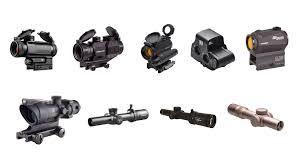
Top 7 Tactical Rifle Scope Selection Tips for Accurate Shooting
Tactical rifle scope selection can be overwhelming given the many available options and features designed to improve shooting precision. Whether you’re preparing for tactical situations, competition shooting, or long-range hunting, picking the right scope is critical to your success. In this article, we’ll provide seven essential tips to guide your tactical rifle scope selection so you can enhance your accuracy and confidence on the range. Understanding these factors will help you invest in a scope that fits your unique shooting needs, environment, and budget.
1. Define Your Shooting Purpose and Environment
Understanding Tactical Applications
Before selecting any scope, identify the primary role your scope will serve. Tactical shooting can encompass urban defense, law enforcement, competition, or long-range precision engagements. Each context demands different features. For instance, close-quarters tactical operations typically benefit from low magnification, quick target acquisition, and illuminated reticles, while precision long-range shooting requires higher magnification and advanced turret adjustments.
Consider Environmental Conditions
The environment you shoot in matters. If you often operate in low light or adverse weather, look for scopes with weatherproofing, fog proofing, and bright lens coatings. Durability and resistance against shock and recoil are also vital to maintain zero and reliability under rugged use. For dusty or humid climates, sealed, nitrogen-purged scopes help maintain clarity and prevent internal fogging.
2. Choose the Right Magnification Range
Variable vs. Fixed Magnification
Understanding magnification options can dramatically influence your tactical rifle scope selection. Variable magnification scopes allow adjustment from a low to a high zoom level (e.g., 1-6x or 3-18x), offering versatility across distances. Fixed magnification scopes provide a single level of zoom, often preferred for simplicity and robustness—ideal for specific tactical tasks.
Match Magnification to Engagement Distance
Consider your typical target range: low magnification (1-4x) enables rapid target acquisition at close quarters, while medium (4-9x) suits both mid-range and dynamic situations. For extended-range precision shooting, scopes with 10x or higher magnification help identify and engage distant targets. Remember, higher magnification can narrow your field of view and reduce image brightness.
3. Select a Tactical Reticle That Enhances Precision
Reticle Types and Their Benefits
Reticles are your aiming reference and come in various designs. Common tactical options include:
- Mil-Dot Reticles: Feature dots spaced for range estimation and holdover corrections, excellent for adjusting to wind and bullet drop.
- BDC (Bullet Drop Compensator) Reticles: Pre-marked aiming points for specific distances streamline long-range shooting without turret adjustments.
- Illuminated Reticles: Offer enhanced visibility in low-light conditions, improving target acquisition speed and accuracy.
First Focal Plane (FFP) vs. Second Focal Plane (SFP)
FFP reticles scale with magnification, keeping measurements correct at all zoom levels—ideal for range estimation during tactical operations. SFP reticles maintain a constant reticle size but require calibration only at one magnification level, which may suffice for simpler tactical approaches or hunting.
4. Evaluate Lens Quality and Coatings for Clarity
The Importance of Objective Lens Size
The objective lens diameter affects light transmission and image brightness. Larger lenses (40mm and above) gather more light, producing brighter images, especially valuable during dawn, dusk, or overcast conditions.
Lens Coatings to Reduce Glare
Look for scopes with fully multi-coated lenses to maximize light transmission and minimize glare. Quality coatings improve contrast and clarity, providing sharp, vivid sight pictures critical in tactical and precision shooting scenarios.
5. Prioritize Durable Construction and Weather Resistance
Materials and Build Quality
A tactical rifle scope needs to withstand harsh recoil, rough handling, and environmental challenges. Opt for scopes with aircraft-grade aluminum bodies engineered for impact resistance.
Weatherproofing Features
Ensure your scope is fog-proof, waterproof, and shockproof. These features prevent internal damage and lens fogging, ensuring consistent performance during adverse conditions and tactical missions.
6. Consider Turret Adjustments and Zero-Stop Functionality
Precise Windage and Elevation Controls
Exposed turrets that provide audible, tactile clicks allow quick, accurate windage and elevation adjustments. This feature is essential for tactical shooters who must compensate for environmental factors rapidly.
Zero-Stop Feature
Some scopes include a zero-stop mechanism on elevation turrets, allowing you to return quickly to your original zero point without guessing. This improves reliability during fast-paced engagements.
7. Choose the Right Mounting Solution for Stability
Mount Compatibility and Stability
Even the highest-quality scope won’t perform well if the mounting system is unstable. Ensure compatibility with your rifle’s base—commonly Picatinny or Weaver rails—and select mounts that provide rock-solid attachment.
Optimal Eye Relief and Cheek Weld
A proper mounting height ensures comfortable eye relief, reducing scope bite and enabling a natural cheek weld on your rifle. Adequate eye relief also minimizes strain during extended shooting sessions.
- Low mounts work well for fixed magnification scopes with smaller objective lenses.
- Higher mounts may be necessary for scopes with larger objective lenses or for rifles with thick stocks.
Exploring scopes with adjustable mounting options, such as quick-detach mounts, can provide additional tactical flexibility.
Bonus Tip: Explore High-Quality Modular Scope Options
To streamline tactical rifle scope selection, consider modular scopes that allow you to adapt features to your needs. For example, scopes with interchangeable reticles, variable magnification inserts, or customizable illumination can extend versatility. Check out optical gear that offers multiple magnification and reticle configurations to suit evolving shooting requirements, such as the versatile scope options with modular capabilities that combine high-quality optics with adaptable features to suit tactical shooters.
Conclusion
Successful tactical rifle scope selection hinges on understanding your shooting purpose, environment, and key features like magnification, reticle type, lens quality, durability, turret controls, and mounting stability. By applying these seven expert tips, you can choose a scope optimized for accurate shooting, whether in competition, tactical defense, or long-range hunting. Take time to evaluate options carefully and consider modular or adaptable scopes to future-proof your investment. To explore adaptable tactical optics designed to meet diverse precision shooting needs, check out our modular tactical rifle scope options today and enhance your shooting accuracy.
